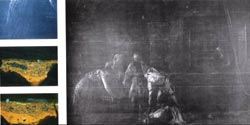
An Artist’s Secrets? Projection and Photoluminescence
More than 200 years before the camera was invented, Italian Renaissance artist Caravaggio (1571-1610) employed photographic techniques to develop his renowned light and shadow paintings, according to Roberta Lapucci, a teacher and researcher at Studio Art Centers International (SACI) in Florence, Italy.

Shown is an x-ray image of Caravaggio’s painting The Beheading of St. John the Baptist and cross-section analyses taken from the artwork.
Background: Art historian Roberta Lapucci noted that there is a higher than average number of left-handed models in works painted by Caravaggio during an early stage of his career. This observation suggests that he may have been unable to reverse the projected image from left to right with the system he used at the time, she said. The photo represents Caravaggio’s painting of St. Catherine.
There is evidence to suggest that the 16th-century artist and his contemporaries to some extent experimented with optics – including lenses, the concave mirror and the camera obscura – as aids in their creative process, Lapucci said. Caravaggio, for example, is known to have worked in a darkened room and to have illuminated his models through a hole in the ceiling, and he did not use preliminary drawings, she added.
Lapucci’s recent research, which she presented at the Brera Museum in Milan in February 2009 and at the Collegio Ghislieri in Pavia in January 2009, both in Italy, provides evidence that Caravaggio may have projected images onto a canvas and used photosensitive materials to fix their outlines. The process may have helped him to better portray the relationships between the models in a dramatic scene.
By the use of photosensitive materials such as mercury salts, a permanent image could be produced within the darkened studio, which functioned as a camera obscura, Lapucci said. “After the projection of the image, a luminous monochromatic simulacrum could remain visible on the canvas, similar to a black-and-white photograph, for about 40 minutes to two hours – only in darkness; a light exposure could have made it vanish,” she explained. “During this time, within the darkened room, the painter could have fixed, with a luminescent white paint, a monochrome (brown priming and white paint) sketch of the projected figures.”
“To trace the main shapes of the highlights in his composition, Caravaggio used a lead white sketch, which seems to confirm his attempts to block a snapshot composition on the canvas before it vanished, or to assemble more figures together in a sort of patchwork,” Lapucci said, adding, “To fix the poses of his models, he always traced some scoring.”
Lapucci said that there is a “Venetian white” paint that was available in the 17th century that was made of 50 percent lead white and 50 percent barium sulfate. “Its use by the Venetian artists and by Caravaggio could be connected to the camera obscura and should be viewed in this new perspective: as a fluorescent material which allowed the artist to paint in the dark within the camera obscura,” Lapucci said.
Light-sensitive and photoluminescent substances were mentioned in the field of natural science by Giovan Battista Della Porta, a 16th-century Italian scholar, scientist and playwright, according to Lapucci.
These photoluminescent substances could be magnesium, silver, mercury or arsenic, in combination with chlorine, sulfur and iodide. She added that salts of these substances could be vaporized, nebulized or mixed to the priming components (usually based on gypsum, animal glue, oil or pigment). She said that nondestructive tests have been used to try to identify these substances in the artwork but that these tests are limited: X-ray fluorescence, for example, identifies only heavy metals and cannot recognize iodide, arsenic or sulfur.
“X-ray fluorescence did not find magnesium in Caravaggio’s artwork, and only a small amount of silver, but it did detect mercury everywhere,” Lapucci said.
Lapucci said that, consequently, it can be supposed that mercury is located in the priming layer. However, to position mercury with certainty, cross sections (requiring destructive testing) or a new kind of analysis would be needed – a sort of x-ray fluorescence that scans for the presence of the element micron by micron to understand where the mercury is located and, consequently, whether the artist exposed the primed canvas to mercury vapors (such as mercury iodide), or mixed the materials with the priming components, or applied these materials over the priming as jelly emulsions.
Published: September 2009